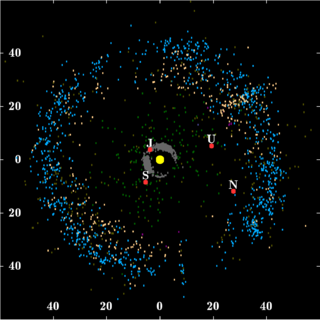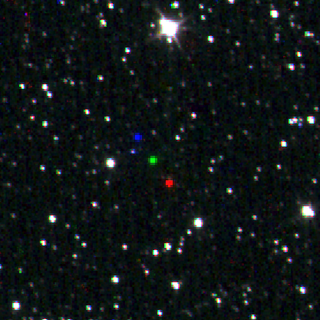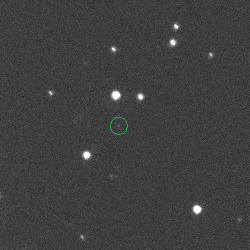Related Research Articles

The Kuiper belt is a circumstellar disc in the outer Solar System, extending from the orbit of Neptune at 30 astronomical units (AU) to approximately 50 AU from the Sun. It is similar to the asteroid belt, but is far larger—20 times as wide and 20–200 times as massive. Like the asteroid belt, it consists mainly of small bodies or remnants from when the Solar System formed. While many asteroids are composed primarily of rock and metal, most Kuiper belt objects are composed largely of frozen volatiles, such as methane, ammonia, and water. The Kuiper belt is home to most of the objects that astronomers generally accept as dwarf planets: Orcus, Pluto, Haumea, Quaoar, and Makemake. Some of the Solar System's moons, such as Neptune's Triton and Saturn's Phoebe, may have originated in the region.

A natural satellite is, in the most common usage, an astronomical body that orbits a planet, dwarf planet, or small Solar System body. Natural satellites are colloquially referred to as moons, a derivation from the Moon of Earth.
Brett James Gladman is a Canadian astronomer and a full professor at the University of British Columbia's Department of Physics and Astronomy in Vancouver, British Columbia. He holds the Canada Research Chair in planetary astronomy. He does both theoretical work and observational optical astronomy.
In ancient times, only the Sun and Moon, a few stars, and the most easily visible planets had names. Over the last few hundred years, the number of identified astronomical objects has risen from hundreds to over a billion, and more are discovered every year. Astronomers need to be able to assign systematic designations to unambiguously identify all of these objects, and at the same time give names to the most interesting objects, and where relevant, features of those objects.

Skathi, also named Saturn XXVII and originally spelled Skadi, is a natural satellite of the planet Saturn. Skathi is one of Saturn's irregular moons, in its Norse group of satellites. It was discovered on September 23, 2000, by a team of astronomers led by Brett Gladman. The team announced their discovery on December 7, 2000, along with seven other satellites of Saturn, namely; Tarvos, Ijiraq, Thrymr, Siarnaq, Mundilfari, Erriapus, and Suttungr. The moon was named after Skaði, a figure in Norse mythology, as part of an effort to diversify the largely Greek and Roman names of astronomical objects.

Siarnaq, also designated Saturn XXIX, is the second-largest irregular moon of Saturn. It was discovered on 23 September 2000 by a team of astronomers led by Brett J. Gladman. It was named after the Inuit goddess of the sea, Siarnaq, who is more commonly known as Sedna. Siarnaq is the largest member of Saturn's Inuit group of prograde irregular moons, which orbit far from Saturn in the same direction as the planet's rotation. The moons of the Inuit group are believed to have originated as fragments from the collisional breakup of a larger progenitor moon after it was gravitationally captured into orbit around Saturn several billion years ago. Several other small Inuit group moons share similar orbits to Siarnaq, indicating that the moon had experienced another collision after forming from its progenitor.
Scott Sander Sheppard is an American astronomer and a discoverer of numerous moons, comets and minor planets in the outer Solar System.

David Clifford Jewitt is a British-American astronomer who studies the Solar System, especially its minor bodies. He is based at the University of California, Los Angeles, where he is a Member of the Institute for Geophysics and Planetary Physics, the Director of the Institute for Planets and Exoplanets, Professor of Astronomy in the Department of Physics and Astronomy and Professor of Astronomy in the Department of Earth, Planetary and Space Sciences. He is best known for being the first person to discover a body beyond Pluto and Charon in the Kuiper belt.

Marc William Buie is an American astronomer and prolific discoverer of minor planets who works at the Southwest Research Institute in Boulder, Colorado in the Space Science Department. Formerly he worked at the Lowell Observatory in Flagstaff, Arizona, and was the Sentinel Space Telescope Mission Scientist for the B612 Foundation, which is dedicated to protecting Earth from asteroid impact events.
Warren B. Offutt was an American amateur astronomer and amateur radio operator.
The naming of moons has been the responsibility of the International Astronomical Union's committee for Planetary System Nomenclature since 1973. That committee is known today as the Working Group for Planetary System Nomenclature (WGPSN).
Matthew J. Holman is a Smithsonian astrophysicist and lecturer at Harvard University. Holman studied at MIT, where he received his bachelor's degree in mathematics in 1989 and his PhD in planetary science in 1994. He was awarded the Newcomb Cleveland Prize in 1998.

Neptune is the eighth planet from the Sun and the farthest IAU-recognized planet in the Solar System. It is the fourth-largest planet in the Solar System by diameter, the third-most-massive planet, and the densest giant planet. It is 17 times the mass of Earth, and slightly more massive than its near-twin Uranus. Neptune is denser and physically smaller than Uranus because its greater mass causes more gravitational compression of its atmosphere. Being composed primarily of gases and liquids, it has no well-defined solid surface. The planet orbits the Sun once every 164.8 years at an average distance of 30.1 astronomical units. It is named after the Roman god of the sea and has the astronomical symbol , representing Neptune's trident.

Discovery and exploration of the Solar System is observation, visitation, and increase in knowledge and understanding of Earth's "cosmic neighborhood". This includes the Sun, Earth and the Moon, the major planets Mercury, Venus, Mars, Jupiter, Saturn, Uranus, and Neptune, their satellites, as well as smaller bodies including comets, asteroids, and dust.
Philip D. Nicholson is an Australian-born professor of astronomy at Cornell University in the Astronomy department specialising in Planetary Sciences. He was editor-in-chief of the journal Icarus between 1998 and 2018.

486958 Arrokoth (provisional designation 2014 MU69; formerly nicknamed Ultima Thule) is a trans-Neptunian object located in the Kuiper belt. Arrokoth became the farthest and most primitive object in the Solar System visited by a spacecraft when the NASA space probe New Horizons conducted a flyby on 1 January 2019. Arrokoth is a contact binary 36 km (22 mi) long, composed of two planetesimals 21 and 15 km (13 and 9 mi) across, that are joined along their major axes. With an orbital period of about 298 years and a low orbital inclination and eccentricity, Arrokoth is classified as a cold classical Kuiper belt object.

2014 PN70 (internally designated g12000JZ, g1 and PT3) is a trans-Neptunian object from the cold classical Kuiper belt located in the outermost region of the Solar System. It measures approximately 40 kilometers (25 miles) in diameter. The object was first observed by the New Horizons Search Team using the Hubble Space Telescope on 6 August 2014, and was a proposed flyby target for the New Horizons probe until 2015, when the alternative target 486958 Arrokoth was selected.

(516977) 2012 HZ84, provisional designation 2012 HZ84, is a small trans-Neptunian object from the Kuiper belt located in the outermost region of the Solar System, approximately 74 kilometers (46 miles) in diameter. It was discovered on 17 April 2012, by a team of astronomers using one of the Magellan Telescopes in Chile during the New Horizons KBO Search in order to find a potential flyby target for the New Horizons spacecraft. In December 2017, this classical Kuiper belt object was imaged by the spacecraft from afar at a record distance from Earth.
(523764) 2014 WC510, is a binary trans-Neptunian object discovered on 8 September 2011 by the Pan-STARRS survey at the Haleakalā Observatory in Hawaii. It was found by Pan-STARRS on 20 November 2014 and was announced later in July 2016 after additional observations and precovery identifications. It is in the Kuiper belt, a region of icy objects orbiting beyond Neptune in the outer Solar System. It is classified as a plutino, a dynamical class of objects in a 2:3 orbital resonance with Neptune. On 1 December 2018, a team of astronomers observed a stellar occultation by the object, which revealed that it is a compact binary system consisting of two separate components in close orbit around each other. The primary and secondary components are estimated to have diameters of around 180 km (110 mi) and 140 km (87 mi), respectively.
2011 JY31 is a binary trans-Neptunian object from the Kuiper belt, located in the outermost region of the Solar System. It was discovered on 4 May 2011, by a team of astronomers using one of the Magellan Telescopes in Chile during the New Horizons KBO Search for a potential flyby target for the New Horizons spacecraft. Distant observations by New Horizons from September 2018 revealed its binary nature, showing two 50 km (31 mi)-wide components in a tight, mutual orbit 200 km (120 mi) apart. The discovery adds support to streaming instability as the dominant mechanism in the formation of tight and contact binary planetesimals such as 486958 Arrokoth, which appear to be prevalent in the cold classical Kuiper belt population.
References
- ↑ "Minor Planet Discoverers (by number)". Minor Planet Center. 4 September 2016. Retrieved 5 November 2016.
- 1 2 "154660 Kavelaars (2004 FX29)". Minor Planet Center. Retrieved 5 November 2016.